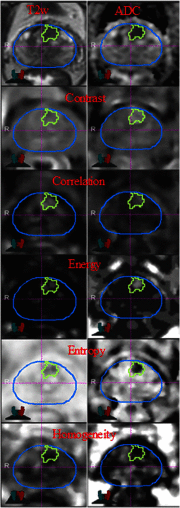Classification of suspicious lesions on prostate multiparametric MRI using machine learning
- PMID: 30840719
- PMCID: PMC6126494
- DOI: 10.1117/1.JMI.5.3.034502
Classification of suspicious lesions on prostate multiparametric MRI using machine learning
Abstract
We present a radiomics-based approach developed for the SPIE-AAPM-NCI PROSTATEx challenge. The task was to classify clinically significant prostate cancer in multiparametric (mp) MRI. Data consisted of a "training dataset" (330 suspected lesions from 204 patients) and a "test dataset" (208 lesions/140 patients). All studies included T2-weighted (T2-W), proton density-weighted, dynamic contrast enhanced, and diffusion-weighted imaging. Analysis of the images was performed using the MIM imaging platform (MIM Software, Cleveland, Ohio). Prostate and peripheral zone contours were manually outlined on the T2-W images. A workflow for rigid fusion of the aforementioned images to T2-W was created in MIM. The suspicious lesion was outlined using the high b-value image. Intensity and texture features were extracted on four imaging modalities and characterized using nine histogram descriptors: 10%, 25%, 50%, 75%, 90%, mean, standard deviation, kurtosis, and skewness (216 features). Three classification methods were used: classification and regression trees (CART), random forests, and adaptive least absolute shrinkage and selection operator (LASSO). In the held out by the organizers test dataset, the areas under the curve (AUCs) were: 0.82 (random forests), 0.76 (CART), and 0.76 (adaptive LASSO). AUC of 0.82 was the fourth-highest score of 71 entries (32 teams) and the highest for feature-based methods.
Keywords: machine learning; multiparametric MRI; prostate cancer.
Figures




References
-
- Mclean R. A., Sanders W. L., Stroup W. W., “A unified approach to mixed linear-models,” Am. Stat. 45(1), 54–64 (1991).10.2307/2685241 - DOI

